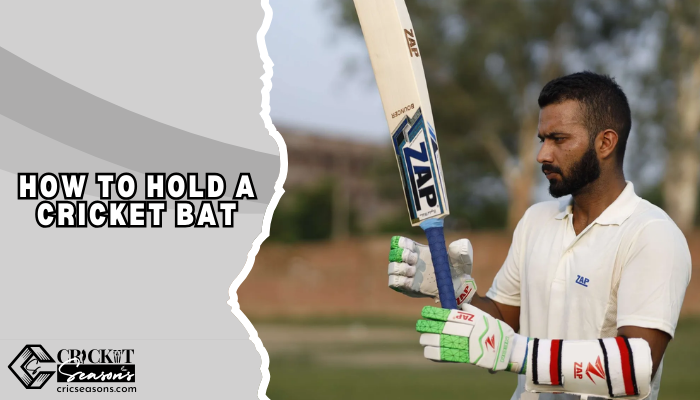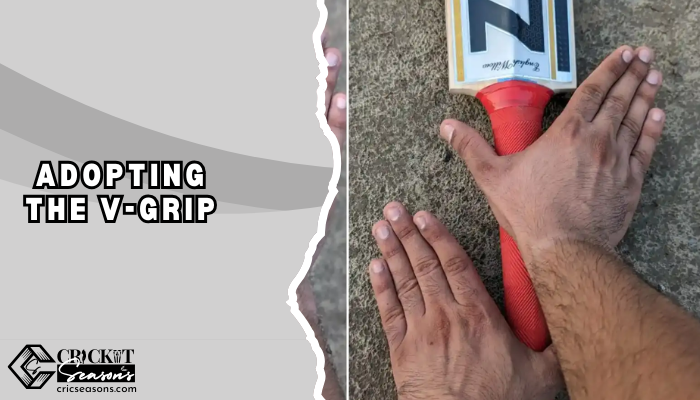Holding a cricket bat correctly is essential for anyone looking to improve their batting performance. Whether you’re a beginner or a seasoned player, understanding the proper technique can make a significant difference. A well-executed grip not only enhances your control over the bat but also helps in delivering powerful and precise shots. Moreover, it minimizes the risk of injuries, particularly to your wrists and fingers. This guide is designed to walk you through the how to hold a cricket bat, ensuring you maximize your potential on the field.
Contents
Understanding the Basics
Before you start focusing on the grip, it’s crucial to select the right cricket bat. The bat should match your height, strength, and playing style. A bat that is too heavy or too light can hinder your performance. It’s important to find one that you can comfortably swing with control.
Next, familiarize yourself with the parts of the bat. The handle is where your hands will grip, and it plays a vital role in controlling the bat. The blade, which is used to hit the ball, needs to be well-balanced with the handle. Understanding the anatomy of the bat helps in holding it correctly, allowing for better shot execution. This basic knowledge forms the foundation for developing a strong and effective batting technique.
Step-by-Step Guide How to Hold a Cricket Bat
Step 1: Positioning Your Hands
To begin, positioning your hands correctly on the bat is crucial. For right-handed players, the left hand is placed at the top of the handle, and the right hand is placed just below it. The left hand acts as the guiding hand, controlling the bat’s direction, while the right hand provides power and stability.
The thumb and forefinger of each hand should form a “V” shape, pointing down the bat’s spine towards the toe. This alignment ensures that your grip is neither too loose nor too tight, allowing for better control during your shots.
Step 2: Adopting the V-Grip
The V-grip is key to holding a cricket bat correctly. This grip allows for fluid movement of the wrists, which is essential for playing different types of shots. To adopt the V-grip, place the top hand so that the V formed by the thumb and forefinger is aligned with the inside edge of the bat.
The bottom hand should mirror this grip but with slightly more flexibility, allowing for easy adjustment during play. A proper V-grip gives you both control and flexibility, making it easier to execute a variety of shots, from defensive blocks to aggressive drives.
Step 3: Ensuring the Right Grip Pressure
Grip pressure is another critical aspect. Holding the bat too tightly can restrict wrist movement, making it harder to play shots with precision. On the other hand, a grip that’s too loose can result in the bat slipping out of your hands.
The ideal grip is firm yet relaxed, allowing for quick wrist movement while maintaining control of the bat. This balance is essential for playing a wide range of cricket shots effectively. Remember, your grip should feel natural and comfortable, as this will help you maintain focus during long batting sessions.
Step 4: Adjusting the Grip for Different Shots
Cricket is a game of variety, and different shots require slight adjustments to your grip. For defensive shots, a firmer grip with less wrist movement is ideal, providing more control over the bat. For attacking shots, like drives or pulls, loosen your bottom hand slightly to allow the bat to follow through naturally.
This flexibility in your grip allows for more power and accuracy, adapting your playing style to the situation at hand. Understanding how to adjust your grip based on the shot you intend to play is crucial for becoming a versatile batsman.
The Role of Stance and Balance
Your stance and balance are just as important as your grip when it comes to batting effectively. Start by positioning your feet shoulder-width apart, which provides a stable base. Your weight should be evenly distributed between both feet, allowing for quick movements either forward or backward depending on the ball’s length. For right-handed players, the left foot should be slightly ahead, with the back foot slightly turned outward.
Maintaining balance is crucial, as it affects both the power and accuracy of your shots. Your knees should be slightly bent, and your body should be upright but relaxed. This posture enables you to shift your weight smoothly when playing shots, helping you maintain control over the bat. Keep your head still and your eyes level with the ball, as this ensures better focus and timing.
Stance and balance go hand in hand with grip, and together they form the foundation of a good batting technique. Practicing your stance in front of a mirror or with a coach can help you identify and correct any flaws, making sure your body is in the best possible position to react to different deliveries.
Common Mistakes and How to Avoid Them
Overgripping the Bat
One of the most common mistakes is gripping the bat too tightly. A tight grip can restrict the natural movement of your wrists, leading to stiff shots and a lack of fluidity in your batting. Overgripping also increases the chances of cramping or fatigue during long innings.
To avoid this, maintain a firm yet relaxed grip, allowing your wrists to move freely while playing shots. This flexibility is key to adapting your technique to different deliveries and conditions.
Incorrect Hand Placement
Another frequent error is placing your hands incorrectly on the bat handle. If your hands are too close together, it can limit your control over the bat, making it difficult to play shots with precision. Conversely, if your hands are too far apart, it can lead to poor power generation.
The ideal hand placement should allow you to control the bat’s movement while also providing enough leverage for powerful shots. Practice positioning your hands correctly, and check your grip regularly during practice sessions to develop muscle memory.
Dominant Bottom Hand
Many players struggle with their bottom hand becoming too dominant, which can lead to mistimed shots and a lack of control. When the bottom hand takes over, it can cause the bat to close too early, resulting in poor shot execution. To correct this, focus on using your top hand to guide the bat, with the bottom hand providing support. This adjustment can be practiced by playing shots with your bottom hand slightly off the handle, which forces the top hand to take control.
Correcting these common mistakes takes practice and attention to detail, but the improvements in your batting technique will be well worth the effort.
Practice Drills for Mastering the Grip
Shadow Batting
One of the most effective drills for mastering your grip is shadow batting. This involves practicing your batting stance and shots without a ball. The focus is purely on your grip, hand placement, and the fluidity of your movements.
Stand in front of a mirror to observe and correct your technique. Repeating this drill regularly helps in developing muscle memory, ensuring that your grip becomes second nature during actual play.
Grip Trainers and Aids
Using grip trainers or aids can be beneficial, especially for beginners. These tools are designed to help you position your hands correctly on the bat. They also help in strengthening your grip, making it easier to maintain control during long innings.
Practicing with these aids can accelerate your learning curve, helping you to internalize the proper technique faster.
Consistent Practice
Consistent practice is key to mastering any skill, and holding a cricket bat is no exception. Dedicate time each day to practice your grip, starting with basic drills and gradually progressing to more complex ones. Incorporate different shot types into your practice sessions to understand how grip adjustments affect your play. Over time, this will help you develop a versatile grip that can adapt to various situations on the field.
Adapting the Grip for Different Conditions
Against Fast Bowlers
When facing fast bowlers, you need to adapt your grip for power and control. A firmer grip helps in absorbing the impact of fast deliveries while maintaining control over the bat. Ensure your top hand maintains a strong hold, which allows you to keep the bat steady.
Your bottom hand should provide support, but it’s crucial not to overgrip, as this can hinder your ability to play quick, reflex-based shots like hooks or pulls.
Against Spin Bowlers
Playing against spin requires a different approach. The grip should be slightly looser, particularly in the bottom hand, to allow for more wrist movement. This flexibility helps in maneuvering the ball, making it easier to play shots with finesse, like sweeps or late cuts.
The looser grip also enables you to adjust quickly to the ball’s turn, giving you better control over your shot placement.
Switching During an Inning
Conditions can change during an inning, requiring you to adjust your grip accordingly. For example, on a bouncy pitch, you might need a firmer grip to control rising deliveries. On slower pitches, a looser grip could help you play delicate shots. Being adaptable with your grip is essential for responding to these changes effectively. Practice different grip variations during training to prepare for various match situations, ensuring you can adjust seamlessly during the game.
Frequently Asked Questions (FAQs)
Q1: How can I prevent my bottom hand from dominating my shots?
Ans: To prevent your bottom hand from dominating your shots, focus on strengthening your top hand. Practice shots with your bottom hand lightly resting on the handle or completely off it. This forces your top hand to control the bat, helping you develop a more balanced grip. Additionally, using a lighter bat can help reduce the tendency to overuse your bottom hand.
Q2: What is the best way to adjust my grip for playing spin bowlers?
Ans: When playing spin bowlers, adjust your grip by loosening your bottom hand slightly. This allows for more wrist flexibility, enabling you to manipulate the ball better. The lighter grip helps in playing shots like sweeps and cuts, which require quick adjustments to the ball’s spin and turn.
Q3: Can using a grip aid improve my performance?
Ans: Yes, using a grip aid can improve your performance by helping you maintain the correct hand position on the bat. These aids are particularly useful for beginners who are learning the fundamentals of grip. They also help in developing muscle memory, ensuring that your hands automatically find the correct position during play.
However, it’s important to practice without the aid as well to ensure that you can maintain your grip in real-game situations.
Q4: How often should I practice these techniques to see improvement?
Ans: Consistent practice is key to seeing improvement. Aim to practice these techniques daily, even if it’s just for a few minutes. Over time, as your muscle memory develops, you’ll notice a significant improvement in your grip and overall batting performance.
Wrapping Up
Mastering the correct way to hold a cricket bat is a fundamental skill that can significantly enhance your batting performance. By focusing on the right grip, stance, and balance, you’ll find yourself playing more confidently and effectively. It’s essential to practice regularly, paying attention to the details of your technique, and making adjustments as needed based on the type of bowlers you face and the conditions you’re playing in.
Remember, even the most experienced players continually refine their grip and stance, understanding that small adjustments can lead to big improvements on the field. Keep practicing with purpose, and soon, holding the bat correctly will become second nature, allowing you to focus on your game and enjoy the sport even more.


